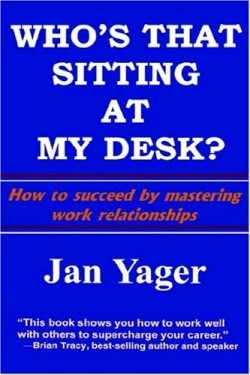Who's That Sitting at My Desk?
How to Succeed by Mastering Work Relationships
“Foes or enemies may be a lot harder to spot than friends in the workplace,” cautions the author, “and at times it may be difficult to understand why they even became that way.” One employee described here learned this lesson painfully: the title of this work refers to the instant hostility created when he, applying for a corporate position, momentarily sat at an existing employee’s desk. The turf-conscious employee never got over it, to the new employee’s lasting detriment.
Yager, a friendship expert and Ph.D. sociologist with more than twenty years’ experience studying business and relationships, uses this incident to introduce her book on workplace interpersonal relations.
The author maintains that workplace relationships are usually helpful. They sometimes become casual acquaintanceships, and occasionally blossom into strong friendships. Yager a coins a word for them: “workships.” Not surprisingly, rules exist for establishing such relationships. And, in the workplace, as in other aspects of life, certain people need to be dealt with extremely carefully. The author’s previous book is When Friendship Hurts, Friendshifts, and Business Protocol; she has taught at several universities, including Temple, Uconn, and Penn State. For Who’s That Sitting at My Desk?, she circulated, collected, and analyzed the results of four hundred written surveys and more than one hundred telephone or in-person interviews.
Yager offers guidelines for developing positive workplace relationships. Her ten principles for beginning a model workship include avoiding coming on “too strong,” and being careful to listen for the work values that fellow employees share with new workers.
Guidelines, principles, and questions are provided for readers wishing to expand their workplace networks. The author observes that trade shows are more useful for reinforcing existing connections than for making new connections. Yager belongs to the National Speakers Association, and notes, “You have to do the relationship building in advance so by the time you arrive, there are people who know and care about you.” In this way, trade show participants have colleagues at each show who will include the new registrant in off-program events.
A chapter on types of foes encountered at work describes some well-known examples of office pests, such as time-wasters, but also some more insidious examples, like the pseudo-confidante. Of particular interest is a chapter consisting of thirty insights on workplace relationships. For example, when economic times are challenging, and the number of equally qualified applicants soars, “who you know” and “who you could know” become more important than “what you know.”
Anyone seeking to improve workplace relationships will benefit from reading this book.
Reviewed by
Leonard F. Charla
Disclosure: This article is not an endorsement, but a review. The publisher of this book provided free copies of the book to have their book reviewed by a professional reviewer. No fee was paid by the publisher for this review. Foreword Reviews only recommends books that we love. Foreword Magazine, Inc. is disclosing this in accordance with the Federal Trade Commission’s 16 CFR, Part 255.

